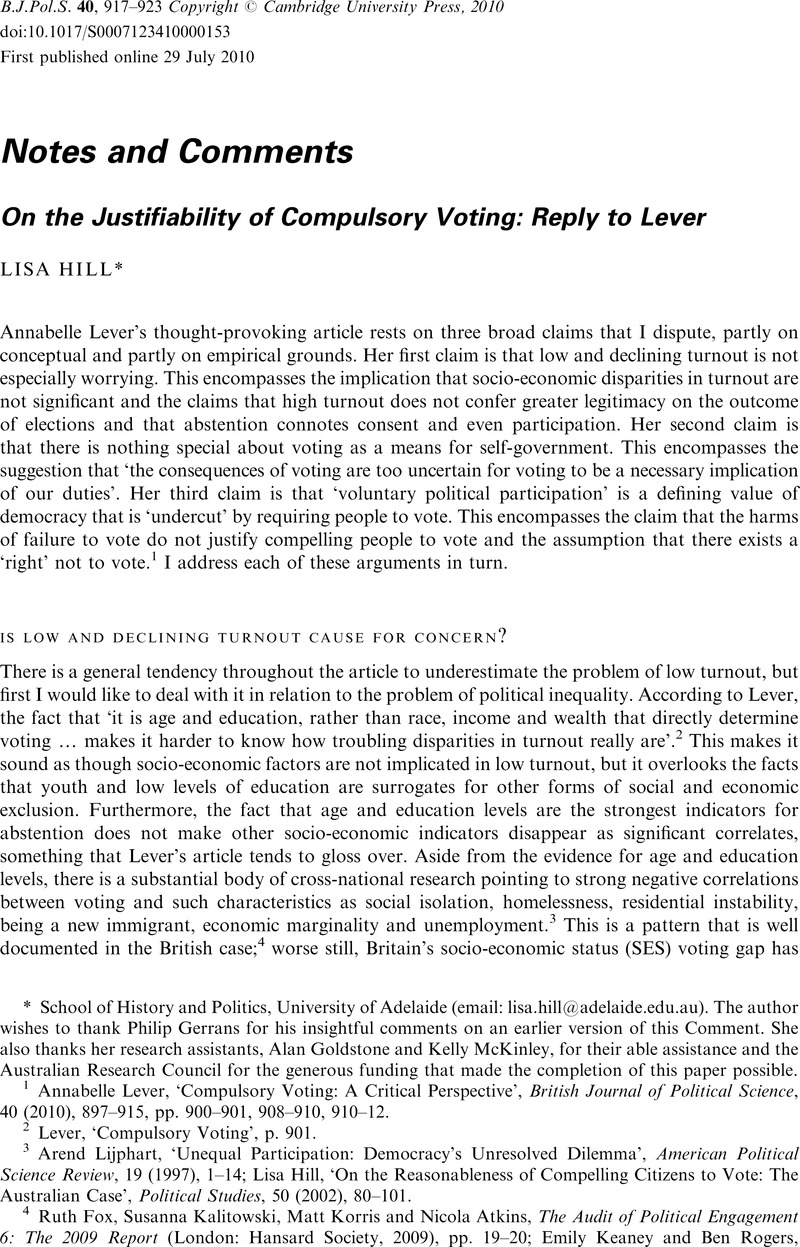Article contents
On the Justifiability of Compulsory Voting: Reply to Lever
Published online by Cambridge University Press: 29 July 2010
Abstract

- Type
- Notes and Comments
- Information
- Copyright
- Copyright © Cambridge University Press 2010
References
1 Lever, Annabelle, ‘Compulsory Voting: A Critical Perspective’, British Journal of Political Science, 40 (2010), 897–915, pp. 900–901, 908–910, 910–12CrossRefGoogle Scholar
2 Lever, , ‘Compulsory Voting’, p. 901Google Scholar.
3 Lijphart, Arend, ‘Unequal Participation: Democracy’s Unresolved Dilemma’, American Political Science Review, 19 (1997), 1–14CrossRefGoogle Scholar; Hill, Lisa, ‘On the Reasonableness of Compelling Citizens to Vote: The Australian Case’, Political Studies, 50 (2002), 80–101CrossRefGoogle Scholar.
4 Fox, Ruth, Kalitowski, Susanna, Korris, Matt and Atkins, Nicola, The Audit of Political Engagement 6: The 2009 Report (London: Hansard Society, 2009), pp. 19–20Google Scholar; Keaney, Emily and Rogers, Ben, A Citizen’s Duty: Voter Inequality and the Case for Compulsory Voting (London: Institute for Public Policy Research, 2006), p. 5Google Scholar. http://www.ippr.org.
5 Rogers, Ben, ‘Turnout is Really about Class: Compulsory Voting Would Give the Less Well Off a Stronger Political Voice’, Guardian, 14 May 2005, p. 20Google Scholar.
6 Lever, , ‘Compulsory Voting’, p. 914Google Scholar.
7 This provokes questions: What are the constitutive features of a democracy? How are democratic institutions justified? Since ‘political equality’ is an ‘intrinsic value’ of democracy ( Weale, Albert, Democracy (London: Macmillan, 1999), p. 42CrossRefGoogle Scholar), then the undisputed capacity of compulsory voting to serve this value in terms of election turnout provides a powerful justification for compelling people to vote.
8 Louth, Jonathon and Hill, Lisa, ‘Compulsory Voting in Australia: Turnout With and Without It’, Australian Review of Public Affairs, 6 (2005), 25–37Google Scholar.
9 Lever, , ‘Compulsory Voting’, p. 907Google Scholar.
10 Lever, , ‘Compulsory Voting’, p. 912Google Scholar.
11 Lever, , ‘Compulsory Voting’, pp. 909–10Google Scholar.
12 Lever, , ‘Compulsory Voting’, p. 911Google Scholar.
13 Henn, Matt and Weinstein, Mark, ‘Youth and Voting Behaviour in Britain’ (paper prepared for the Annual Meeting of the American Political Science Association, San Francisco, 2001), pp. 19–20Google Scholar. See http://pro.harvard.edu/papers/050/050001HennMatt00.pdf
14 Lever, , ‘Compulsory Voting’, p. 909Google Scholar.
15 Lever, , ‘Compulsory Voting’, pp. 911–12Google Scholar.
16 Lever, , ‘Compulsory Voting’, p. 906Google Scholar.
17 Verba, S. and Nie, N. H., Participation in America: Political Democracy and Social Equality (New York: Harper & Row, 1972), p. 338Google Scholar.
18 Dean Burnham, Walter, ‘The Turnout Problem’, in A. James Reichly, ed., Elections American Style (Washington, D.C.: The Brookings Institution, 1987), pp. 97–133Google Scholar, at p. 99.
19 These findings tend to contradict Lever’s imputation that compulsory voting achieves ‘nothing more than raise turnout’, if that. See Chong, Alberto and Olivera, Mauricio, ‘On Compulsory Voting and Income Inequality in a Cross-Section of Countries’, Working Paper No. 533 (Washington, D.C.: Inter-American Development Bank Research Department, 2005)Google Scholar; and also Mueller, Dennis C. and Stratmann, Thomas, ‘The Economic Effects of Democratic Participation’, Journal of Public Economics, 87 (2003), 2129–2155CrossRefGoogle Scholar.
20 Ciccone, Anthony, ‘The Constitutional Right to Vote is Not a Duty’, Hamline Journal of Public Law and Policy, 23 (2002), 325–357Google Scholar, pp. 325 and 328
21 United States Supreme Court, Evans v. Cornman, 398 U.S. 419 (1970), p. 422.
22 Lever, , ‘Compulsory Voting’, p. 910Google Scholar.
23 Pettit, Philip, ‘Analytical Philosophy’, in Robert E. Goodin and Philip Pettit, eds, A Companion to Contemporary Political Philosophy (London: Wiley-Blackwell, 1995), pp. 7–38Google Scholar, at p. 32.
24 Pettit, Philip, ‘Consequentialism’, in P. Singer, ed., A Companion to Ethics (Oxford: Blackwell, 1991), pp. 230–240Google Scholar, at p. 231.
25 Lever, , ‘Compulsory Voting’, p. 912Google Scholar.
26 Lever, , ‘Compulsory Voting’, p. 910Google Scholar.
27 Hill, ‘On the Reasonableness of Compelling Citizens to Vote’.
28 Calabresi, Guido and Douglas Melamed, A., ‘Property Rules, Liability Rules and Inalienability: One View of the Cathedral’, Harvard Law Review, 85 (1972), 1089–1128CrossRefGoogle Scholar, p. 1113.
29 Goodin, Robert, Political Theory and Public Policy (Chicago: University of Chicago Press, 1982), p. 49Google Scholar.
30 Lever, , ‘Compulsory Voting’, pp. 911–12Google Scholar.
31 Anonymous, ‘The Case for Compulsory Voting in the United States’, Harvard Law Review, 121 (2007), 591–612Google Scholar, p. 599; Fellman, David, The Defendant’s Rights Today (Madison: University of Wisconsin Press, 1976), p. 182Google Scholar.
32 Kreimer, Seth F., ‘The Problem of Negative Rights in a Positive State’, University of Pennsylvania Law Review, 132 (1984), 1293–1397CrossRefGoogle Scholar, p. 1387.
33 Kreimer, , ‘The Problem of Negative Rights’, pp. 1387–8Google Scholar.
34 Anonymous, ‘The Case for Compulsory Voting’, p. 600Google Scholar.
- 14
- Cited by


